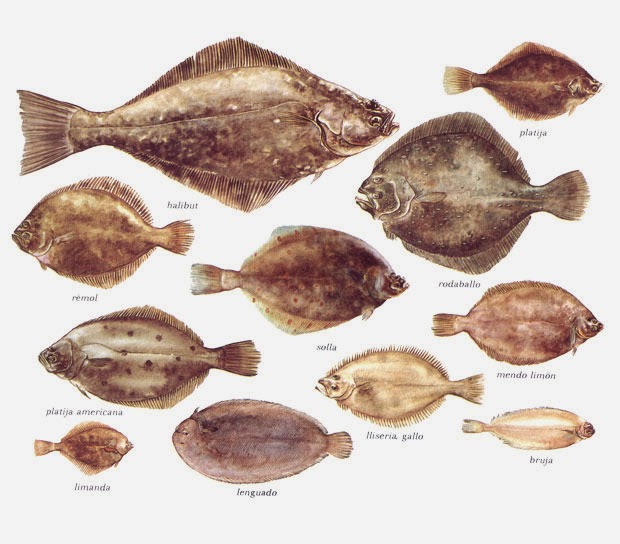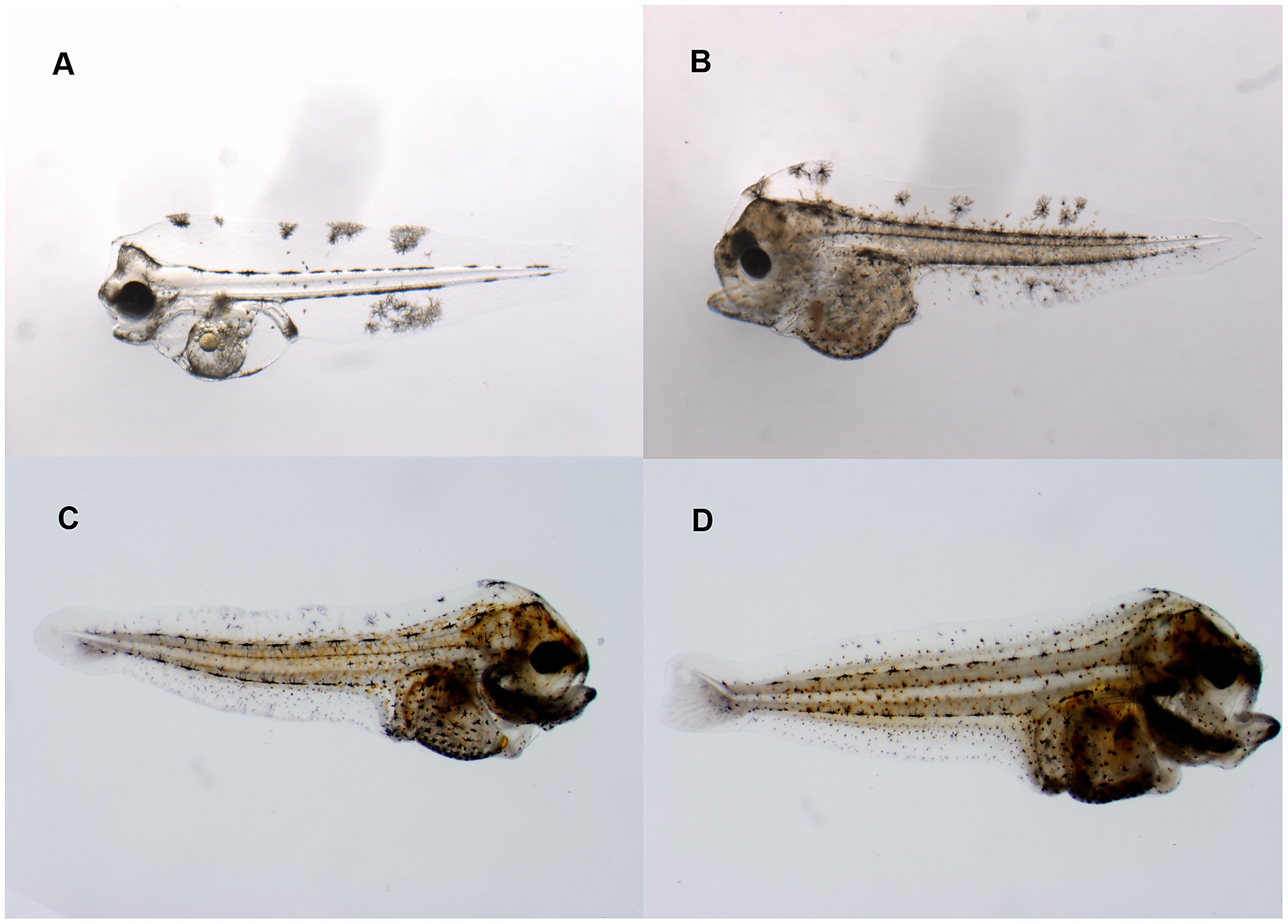Fish are the group of vertebrates with the both largest number of species and the largest number of forms. But virtually all of them are bilaterally symmetrical. The only major exception is the group comprising the various sole and other species such as turbot, flounder, redfish, megrim, halibut, halibut, etc. This group of fish, called flatfish (because of their morphology) or Pleuronectiformes are the only vertebrates that are totally asymmetrical. Since ancient times, attempts have been made to explain the origin of this characteristic morphology of flatfish, but without much success. At present, advances in sciences such as Paleontology, Morphology and Comparative Development or Genomics are contributing to unraveling this enigma.

The asymmetry of flatfish to the present day
Flatfish when hatched as larvae or juveniles are symmetrical, with eyes and fins placed bilaterally, like normal fish. And they live above the sea bed (they are pelagic). But when they advance in their development, and more specifically, when they lose the swim bladder that allows them to stay afloat, they experience a real “tsunami”, a metamorphosis acquiring a strange appearance. One that is totally flattened, with a developed and pigmented upper side, an asymmetrical skull in which the two eyes are together and inclined with respect to the twisted mouth, and a less developed whitish lower side for example, as far as the fins are concerned. They are flattened sideways and not from bottom to top as is the case with rays, for example. Thus they are very well adapted to a way of life as adults in the depths of the ocean, as they are benthics, since their strange shape allows them to move, feed and defend themselves adequately in this environment.
With this peculiar shape, it is not surprising that people have been trying to explain their asymmetry since ancient times. Thus, in the Jewish people’s spoken tradition and legends, soles are called Moses’ fish, either because they were split in half when the prophet separated the waters of the Dead Sea, or because, distracted, they were burned on one side when he was cooking them. In other “versions” it was St. Peter who was burned by the flatfish. And even the Romans called the sole the sole of Jupiter because of its shape.

Turning to scientific explanations of the phenomenon, perhaps the first scientist who tried to explain the asymmetry of flatfish was Lamarck. In his Zoological Philosophy (1809) he explained that surely these fish in their “need” to be always attentive to what is happening above them experienced the displacement of an eye, their flattening and all their other characteristics. The use of some organs, for example the eyes, and the disuse of others, for example the fins on the ventral side, to fulfill this need is what would have led to their peculiar morphology, according to Lamarck.
Meanwhile, fifty years later, Darwin partly accepted this explanation in his The Origin of Species but added that natural selection acting on spontaneous variations of initially symmetrical, small, progressive and heritable fishes in the direction of the phenotype of flatfishes must also have played an important role.
This type of “gradualist” explanations met with strong criticism from, for example, St. George Mivart who in 1871 argued that incipient transformations towards asymmetry, rather than being beneficial, would be detrimental. For example, an intermediate eye position that migrates between symmetry and asymmetry would not prevent its possible rubbing against the background and would not be of much use for seeing what is happening above the fish. And so the controversy remained very much up in the air.
Thus, when it was discovered that genes controlled the variations in living things, there was a geneticist, Richard Goldschmidt, who in 1933 argued that flatfish were a good example of what he called “hopeful monsters”: they would be due to important mutations in genes that are expressed in the initial stages of development and that finally in adults give rise to forms very different from the initial ones; in this case asymmetrical fish from symmetrical fish 1.
The explanation of asymmetry today
In the present day, a series of discoveries and advances are making it possible to delve deeper into the mystery of the origin of the peculiar morphology of these fish.
First of all, recent paleontology studies have found that fossil flatfish from 45 million years ago had eyes, and their morphology in general, in intermediate positions between symmetrical and symmetrical arrangement 2 . This demonstrates two things. Firstly, that such forms were viable and secondly, that the process of evolution from symmetry to asymmetry went through intermediate stages and did not happen by an abrupt change.
On the other hand, comparative studies of the asymmetry of the different species of flatfish, and studies on the evolutionary relationships of the different species (there are more than 700 species spread throughout the world, mostly in marine environments and some in river estuaries), also make it possible to study the origin of the asymmetry in greater depth. It is now well known that not all flatfish species are equally asymmetrical. Some “twist” to the right side (e.g. common sole or flounder) and others to the left side (turbot). Then there are species such as the Senegalese sole, in which most specimens do it to one side, in this case to the right, and a few to the other: there is a polymorphism. Finally, there is a fourth group of species such as thornback turbot in which both dextrorse and sinistrorse specimens occur in equal frequency. Since this fourth group of species is the closest to the origin of the flatfish evolutionary tree – they are the oldest species currently existing – and are even the ones with the least asymmetry, it can be thought that the appearance of asymmetry must have been a process that first occurred randomly or in relation to environmental variations in this group, and that later was controlled by genes in the other species 3.

Thirdly, several studies of the genomes and transcriptomes of flatfish are currently underway. In principle, the main objective is to know this data in order to improve the farming of some of them, such as Senegalese sole, turbot or halibut. But they are also being applied to try to understand the molecular basis of the asymmetry 4. In general, studies show that there are no abrupt changes in any single gene during development, but that in their development there are several changes in the expression of certain genes (such as those related to retinoic acid, thyroid hormone, eye opsins, genes of signaling pathways for bone formation – WNT genes – etc.); and it is these cascading changes that explain the various characteristics of flatfish: asymmetry and coloration, above all.
And to finish as we began, with History, knowledge of its asymmetry makes it possible, for example, to determine to which species some of the cave paintings depicting flatfish belong. This is what happens with the large cave painting in the cave of La Pileta Benaoján-Málaga, which is more than 10,000 years old and which, due to its general appearance and its right-hand twist, may belong to a flounder.
BIBLIOGRAPHY
- Goldschmidt, R. 1933. Some aspects of evolution. Science, 78:539-547. Darwin’s “The Origin of Species” and Mivart’s “The Genesis of Species” can be consulted on the Internet. Lamarck’s “Zoological Philosophy” is apparently not available in its entirety on the web, only parts, but in 1986, Altafulla Mundo Científico published a paper translation.
- Friedman, M. 2008.The evolutionary origin of flatfish asymmetry. Nature, 454:209-212.
- Palmer, A.P. 2009. Animal asymmetry. Current Biology, you can google it.
- Shao, Ch. et al. 2017. The genome and transcriptome of Japanese flounder provide insights into flatfish asymmetry. Nature Genetics, 49(1): 119-124
Comments on this publication